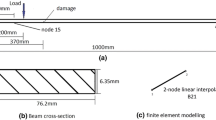Abstract
This work presents a new damage-detection approach for structural systems that uses the transmissibility and coherence functions of the output angular velocity between two points on the structure, at locations where damage may occur, to generate a damage index as a metric of the changes in the dynamic integrity of the structure. The efficacy of the proposed damage index as compared to that based on the traditional transmissibility of acceleration was tested on straight beams. The experimental and numerical results showed that the new damage index outperformed that based on acceleration by multiple levels in terms of detecting and localizing damage. The experimental results also showed that the proposed damage index using gyroscopes was much less sensitive to the environmental acoustic noises under consideration (65–85 dB) when compared with the damage index based on the acceleration.










Similar content being viewed by others
References
Chang P, Flatau A, Liu S (2003) Review paper: health monitoring of civil infrastructure. Struct Health Monit 2(3):257–267. https://doi.org/10.1177/1475921703036169
Inventory NB (2012) Deficient bridges by highway system 2012. US Department of Transportation. https://www.fhwa.dot.gov/bridge/nbi/no10/defbr12.cfm. Accessed 26 Sept 2016
Rytter A (1993) Vibrational based inspection of civil engineering structures. Thesis (doctoral)—Aalborg University, 1993
Fan W, Qiao P (2011) Vibration-based damage identification methods: a review and comparative study. Struct Health Monit. https://doi.org/10.1177/1475921710365419
Doebling SW, Farrar CR, Prime MB (1998) A summary review of vibration-based damage identification methods. Shock Vib Digest 30(2):91–105
Chen J-C, Garba JA (1988) On-orbit damage assessment for large space structures. AIAA J 26(9):1119–1126. https://doi.org/10.2514/3.10019
Hajela P, Soeiro FJ (1990) Structural damage detection based on static and modal analysis. AIAA J 28(6):1110–1115. https://doi.org/10.2514/3.25174
Crema LB, Castellani A, Coppotelli G (1995) Damage localization in composite material structures by using eigenvalue measurements. American Society of Mechanical Engineers, New York
Sampaio RPC, Maia NMM, Silva JMM (1999) Damage detection using the frequency-response-function curvature method. J Sound Vib 226(5):1029–1042. https://doi.org/10.1006/jsvi.1999.2340
Ratcliffe CP (2000) A frequency and curvature based experimental method for locating damage in structures. J Vib Acoust 122(3):324–329
Cawley P, Adams RD (1979) A vibration technique for non-destructive testing of fibre composite structures. J Compos Mater 13(2):161–175
Vantomme J (1992) Evaluation of structural joints in composites with modal parameters. Compos Struct 22(4):201–205. https://doi.org/10.1016/0263-8223(92)90056-I
Chang K, Shen Z, Lee G (1995) Modal analysis technique for bridge damage detection. In: Nondestructive testing methods for civil infrastructure. American Society of Civil Engineers, pp 1–16. https://doi.org/10.1061/9780784401316.001
Worden K (1997) Structural fault detection using a novelty measure. J Sound Vib 201(1):85–101
Johnson T, Adams DE, Schiefer M (2002) An analytical and experimental study to assess structural damage and integrity using dynamic transmissibility. In: SPIE proceedings series. Society of Photo-Optical Instrumentation Engineers
Maia NM, Almeida RA, Urgueira AP, Sampaio RP (2011) Damage detection and quantification using transmissibility. Mech Syst Signal Process 25(7):2475–2483
Johnson TJ, Adams DE (2002) Transmissibility as a differential indicator of structural damage. J Vib Acoust 124(4):634–641
Li J, Hao H (2013) Damage detection of shear connectors based on power spectral density transmissibility. In: Key engineering materials. Trans Tech Publ, pp 1241–1248
Schallhorn C, Rahmatalla S (2015) Crack detection and health monitoring of highway steel-girder bridges. Struct Health Monit 14(3):281–299
Miller R (1973) Factors influencing accelerometer measurement capabilities—a practical measurement guide. David W Taylor Naval Ship Research and Development Center, Bethesda
Castro S, Dean R, Roth G, Flowers GT, Grantham B (2007) Influence of acoustic noise on the dynamic performance of mems gyroscopes. In: ASME 2007 international mechanical engineering congress and exposition. American Society of Mechanical Engineers, pp 1825–1831
Dean RN, Castro ST, Flowers GT, Roth G, Ahmed A, Hodel AS, Grantham BE, Bittle DA, Brunsch JP (2011) A characterization of the performance of a mems gyroscope in acoustically harsh environments. IEEE Trans Ind Electron 58(7):2591–2596
Wu Z, Li S (2007) Two-level damage detection strategy based on modal parameters from distributed dynamic macro-strain measurements. J Intell Mater Syst Struct 18(7):667–676
Sung SH, Lee JH, Park JW, Koo KY, Jung HJ (2014) Feasibility study on an angular velocity-based damage detection method using gyroscopes. Meas Sci Technol 25(7):075009
Al-Jailawi S, Rahmatalla S (2017) Damage detection in structures using angular velocity. J Civil Struct Health Monit 7(3):359–373
Liao Y, Kiremidjian AS, Rajagopal R, Loh C-H (2016) Angular velocity-based structural damage detection. In: Sensors and smart structures technologies for civil, mechanical, and aerospace systems 2016. International Society for Optics and Photonics, p 98031N
Sung S, Park J, Nagayama T, Jung H (2013) A multi-scale sensing and diagnosis system combining accelerometers and gyroscopes for bridge health monitoring. Smart Mater Struct 23(1):015005
Podder P, Khan TZ, Khan MH, Rahman MM (2014) Comparative performance analysis of Hamming, Hanning and Blackman window. Int J Comput Appl 96(18):1–7
Xsens N (2010) Mti and Mtx user manual and technical documentation
Acknowledgements
None.
Author information
Authors and Affiliations
Corresponding author
Ethics declarations
Conflicts of interest
There are no conflicts of interest.
Additional information
Publisher's Note
Springer Nature remains neutral with regard to jurisdictional claims in published maps and institutional affiliations.
Rights and permissions
About this article
Cite this article
Al-Jailawi, S., Rahmatalla, S. Transmissibility-based damage detection using angular velocity versus acceleration. J Civil Struct Health Monit 8, 649–659 (2018). https://doi.org/10.1007/s13349-018-0297-0
Received:
Accepted:
Published:
Issue Date:
DOI: https://doi.org/10.1007/s13349-018-0297-0



